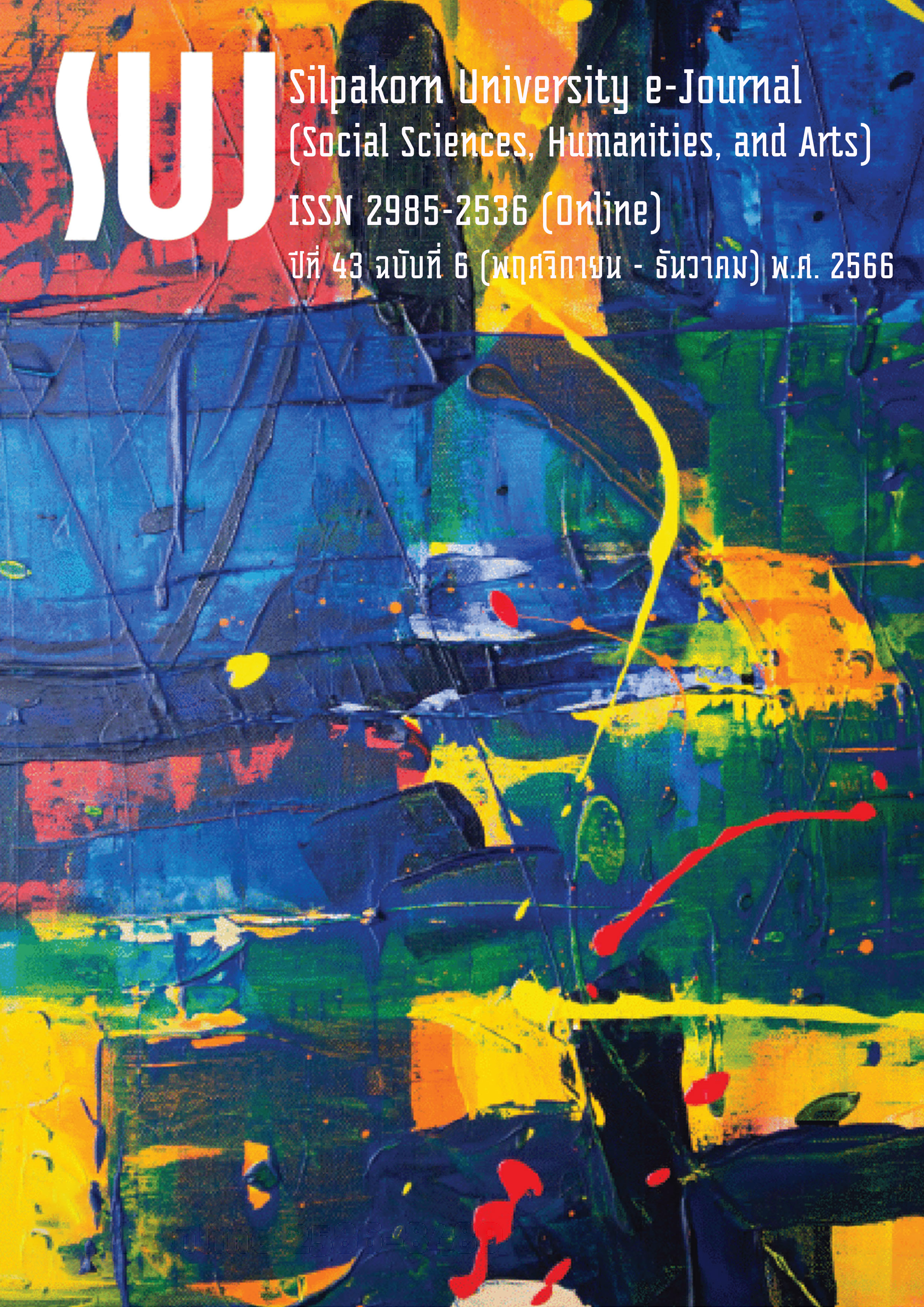สืบสานเพื่อสร้างสรรค์: การใช้วรรณคดีไทยและเทพปกรณัมฮินดูในนวนิยายชุด นวหิมพานต์ ของอลินา (Creation through continuity: The use of Thai literature and Hindu mythology in Alina’s Nava-Himmapan novel series)
Main Article Content
Abstract
บทความนี้มีวัตถุประสงค์เพื่อ 1) ศึกษาการนำวรรณคดีไทยและเทพปกรณัมฮินดูมาสร้างสรรค์เป็นนวนิยายชุดนวหิมพานต์ ของอลินา และ 2) วิเคราะห์บทบาทของการใช้วรรณคดีไทยและเทพปกรณัมฮินดูในนวนิยายชุด นวหิมพานต์ ของอลินา โดยใช้วิธีวิจัยเอกสาร ผลการศึกษา พบว่า อลินาสร้างองค์ประกอบของเรื่องจากวรรณคดีไทยและเทพปกรณัมฮินดู 4 ลักษณะ ได้แก่ 1) การสร้างสรรค์ฉากจากความเชื่อในไตรภูมิกถา 2) การสร้างตัวละครจากความเชื่อในไตรภูมิกถาและเทพปกรณัมฮินดู 3) การสืบทอดอนุภาคจากวรรณคดีไทย และ 4) การสร้างปมขัดแย้งและแบบเรื่องจากวรรณคดีไทยและเทพปกรณัมฮินดู การใช้วรรณคดีไทยและเทพปกรณัมฮินดูในนวนิยายชุด นวหิมพานต์ ของอลินา มีบทบาท 3 ประการ คือ 1) การนำแสนอแนวคิด 2) บทบาทในการขับเน้นอัตลักษณ์ของนวนิยายของอลินา และ 3) บทบาทในการนำเสนอมุมมองต่อมายาคติในสังคม การสร้างนวนิยายชุดนี้ของอลินาแสดงให้เห็นว่าวรรณคดีและเทพปกรณัมเป็นรากสำคัญในการสร้างสรรค์นวนิยายแนวเหนือจริง ทั้งยังสะท้อนให้เห็นวัฒนธรรมทางวรรณศิลป์ของไทยที่ผลงานในชั้นหลังสร้างขึ้นด้วยการถักทอจากตัวบทที่สร้างขึ้นก่อน และการผสมผสานลักษณะเฉพาะของนักเขียน แนวทางศึกษาวรรณกรรมร่วมสมัยที่เกิดจากการสืบสานวรรณคดีฉบับนี้สามารถนำไปประยุกต์ใช้กับตัวบทอื่น ๆ ได้อย่างกว้างขวาง
This article examines the utilization and significance of Thai literature and Hindu mythology in Alina’s Nava-Himmapan novel series through documentary research. The study reveals that there are four characteristics of Thai literature and Hindu mythology in the novels. First, the settings are created from the belief in Tribhumikatha. Second, the characters are fashioned from the belief in Tribhumikatha and Hindu mythology. Third, there are references to motifs from Thai literature. Fourth, conflicts and tale types are derived from Thai literature and Hindu mythology. Thai literature and Hindu mythology in the Nava-Himmapan novel series of Alina serve three significant roles: 1) conveying the theme of the novels; 2) accentuating the identity of Alina’s novels; and 3) presenting viewpoints about myths in society. The creation of the Nava-Himmapan novel series not only underscores the importance of literature and mythologies as foundational elements in the crafting of fantasy novels, but also reflects Thai literary culture. In this cultural context, new texts emerge from former texts, receiving a fresh identity from the author. This approach, used to study the continuity of classic literature in contemporary literature, can be applied to study a diverse array of texts.
Downloads
Article Details

This work is licensed under a Creative Commons Attribution-NonCommercial-NoDerivatives 4.0 International License.
References
Alina (Salikupta, Parichat). (2015). The Secondary Demon (ทุติยอสูร). Bangkok: Lookangoon Press.
Alina (Salikupta, Parichat). (2016). The Greatest God (เอกเทพ). Bangkok: Lookangoon Press.
Alina (Salikupta, Parichat). (2017). The Wedding of Phittayathorn (วิวาห์พิทยาธร). Bangkok: Lookangoon Press.
Alina (Salikupta, Parichat). (2018a). Giant’s Diamond (เพชรรากษส) (2nd ed.). Bangkok: Lookangoon Press.
Alina (Salikupta, Parichat). (2018b). The Black Naga (นิลนาคินทร์). Bangkok: Lookangoon Press.
Alina (Salikupta, Parichat). (2018c). Three Magic Eyes (ตรีเนตรทิพย์) (2nd ed.). Bangkok: Lookangoon Press.
Anuman Rajadhon, Phraya. (1969). Narrating the Story of Three Worlds of Sathiankoset (เล่าเรื่องในไตรภูมิของเสฐียรโกเศศ). n.p.
Boonpok, Pratuan. (1980). Gandharvas in Sanskrit and Pali Literatures (คนธรรพ์ในวรรณคดีสันสกฤตและวรรณคดีบาลี). Master’s dissertation, Chulalongkorn University, Bangkok, Thailand.
Busyakul, Visuth. (1977). Visuth’s Writing (วิสุทธนิพนธ์). Bangkok: Odeon Store.
Chaiprasert, Jansuda. (2017). “Beyond Reality” in Thai Literary Culture: A Case Study of Contemporary Thai Literary Works (“ลักษณะเหนือจริง” ในวัฒนธรรมวรรณศิลป์ไทย: กรณีศึกษาวรรณกรรมร่วมสมัย). Doctoral dissertation, Chulalongkorn University, Bangkok, Thailand.
Khui-Iam, Suwanna. (2018). Creative Perpetuation of Thai Classic Literature in Pongsakorn’s Novels (การสืบสรรค์วรรณคดีมรดกของไทยในนวนิยายของพงศกร). Master’s dissertation, Thammasat University, Bangkok, Thailand.
Laksanasiri, Chulairat, & Intaraporn, Weerawat. (2021). The influence of Kamanita and Lilit Phar Lo on the Chula Treekhun novel of Phanomthian (อิทธิพลของกามนิตและลิลิตพระลอในนวนิยายเรื่อง จุฬาตรีคูณ ของพนมเทียน). Thai Language and Literature, 38(1): 109-161.
Na Thalang, Siraporn. (2005). Theory of Folklore: Methodology to Analyze Myths-Folk Tales (ทฤษฎีคติชนวิทยา: วิธีวิทยาในการวิเคราะห์ตำนาน-นิทานพื้นบ้าน). Bangkok: Chulalongkorn University Press.
Nookur, Kreekamon. (2021). Using literature to create the novel “Ruthailak” (การใช้วรรณคดีสร้างสรรค์นวนิยายเรื่อง “ฤทัยลักษมณ์”). Liberal Arts Review, 16(1): 85-99.
Nueakhlong, Pawisuda, Wattanachai, Warames, & Chaowalitprapan, Preeyarat. (2019). Intertextuality of Navahimmapan serial novel and the Tripoom percept (สัมพันธบทในนวนิยายชุดนวหิมพานต์กับคติไตรภูมิ). In P. Jeennoon (Ed.), Proceeding of the Second National Conference about Thai Language, and Cultural Studies, (pp. 168-179). Songkhla: Faculty of Humanities and Social Sciences, Thaksin University.
Phrasirimangalajarn. (1980). The Explanation about Universe (จักกวาฬทีปนี) (T. Thongsawet, Trans.). Bangkok: Central Express Studies Printing. [Online]. Retrieved August 15, 2022 from https://www.finearts.go.th/songkhlalibraryk/view/17182-จักกวาฬทีปนี
Phra Sunthorn Vohara. (2012). Phra Aphai Mani (พระอภัยมณี). Bangkok: Thaiqualitybooks.
Plainoi, Sombat. (2009). Himmapan Animals (สัตว์หิมพานต์) (4th ed.). Bangkok: Pimkham.
Plainoi, Sombat. (2012a). The Story of Devas (เทวนิยาย) (4th ed.). Bangkok: Gypzy Group.
Plainoi, Sombat. (2012b). The Story of Non-humans (อมนุษยนิยาย) (4th ed.). Bangkok: Gypzy Group.
Prachakul, Nopphorn. (2009a). Rearrange Characters Return to Thinking Volume 1 Regarding Literature (ยอกอักษร ย้อนความคิด เล่ม 1 ว่าด้วยวรรณกรรม). Bangkok: Arn.
Prachakul, Nopphorn. (2009b). Rearrange Characters Return to Thinking Volume 2 Regarding Social Science and Humanities (ยอกอักษร ย้อนความคิด เล่ม 2 ว่าด้วยสังคมศาสตร์และมนุษยศาสตร์). Bangkok: Arn.
Ratchatakorntrakoon, Ratchaneekorn. (2018). The use of Thai literature in Pongsakorn’s novels (การใช้วรรณคดีไทยในนวนิยายของพงศกร). Journal of the Faculty of Arts, Silpakorn University, 40(2): 74-103.
Royal Society. (1929). Royal Script: Sangthong (พระราชนิพนธ์บทละครเรื่องสังข์ทอง). [Online]. Retrieved October 24, 2023 from https://vajirayana.org/บทละครนอกเรื่องสังข์ทอง
Ruengruglikit, Cholada. (2005). A case study of vocabulary in Thai literature: Chamlaeng-insi, Chamlaeng-plaengkai, Chamlaeng-kai, Chamlaeng-rang and other words of related meanings (คำศัพท์ในวรรณคดีไทย: กรณีศึกษากลุ่มคำ “จำแลงอินทรีย์” “จำแลงแปลงกาย” “จำแลงกาย” “จำแลงร่าง” และคำอื่น ๆ ที่มีความหมายคล้ายกัน). The Journal of the Royal Institute of Thailand, 30(4): 1055-1077.
Silpanon, Dendao. (n.d.). Narrating the Story of Iconography: Vijadhara/Vidayadhara (เล่าเรื่องประติมานวิทยา : วิชาธร/วิทยาธร). The Fine Arts Department. [Online]. Retrieved October 20, 2023 from https://www.finearts.go.th/promotion/view/19045
The Fine Arts Department, Ministry of Culture. (2012). Three Worlds: Transcription Edition (ไตรภูมิกถาฉบับถอดความ) (2nd ed.). [Online]. Retrieved August 15, 2022 from https://shorturl.asia/s7loI
Wattanapreechanont, Penvisa. (2007). Literary Techniques in Kingchat’s Detective Novels (กลวิธีการประพันธ์ในนวนิยายแนวสืบสวนสอบสวนของกิ่งฉัตร). Master’s dissertation, Chulalongkorn University, Bangkok, Thailand.
Wimuttisuk, Jeeranat. (2007). The Use of Thai Literature and Folk Literature in Kaeokao’s Novels (การใช้วรรณคดีไทยและวรรณกรรมพื้นบ้านในนวนิยายของแก้วเก้า). Master’s dissertation, Chulalongkorn University, Bangkok, Thailand.
Yasingor, Nayida. (2020). Politics of race in Trinettip and Tutiyaasun (การเมืองเรื่องเผ่าพันธุ์ในนวนิยายตรีเนตรทิพย์ และทุติยอสูร). Journal of Humanities and Social Sciences, Prince of Songkla University, 16(1): 27-53. [Online]. Retrieved October 22, 2023 from https://so03.tci-thaijo.org/index.php/eJHUSO/article/view/223236


